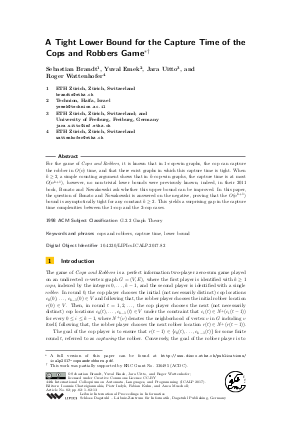A Tight Lower Bound for the Capture Time of the Cops and Robbers Game
Authors Sebastian Brandt, Yuval Emek, Jara Uitto, Roger Wattenhofer
-
Part of:
Volume:
44th International Colloquium on Automata, Languages, and Programming (ICALP 2017)
Part of: Series: Leibniz International Proceedings in Informatics (LIPIcs)
Part of: Conference: International Colloquium on Automata, Languages, and Programming (ICALP) - License:
 Creative Commons Attribution 3.0 Unported license
Creative Commons Attribution 3.0 Unported license
- Publication Date: 2017-07-07
File

PDF
LIPIcs.ICALP.2017.82.pdf
- Filesize: 0.55 MB
- 13 pages
Document Identifiers
Subject Classification
Keywords
- cops and robbers
- capture time
- lower bound
Metrics
- Access Statistics
-
Total Accesses (updated on a weekly basis)
0PDF Downloads0Metadata Views
Abstract
For the game of Cops and Robbers, it is known that in 1-cop-win graphs, the cop can capture the robber in O(n) time, and that there exist graphs in which this capture time is tight. When k >= 2, a simple counting argument shows that in k-cop-win graphs, the capture time is at most O(n^{k + 1}), however, no non-trivial lower bounds were previously known; indeed, in their 2011 book, Bonato and Nowakowski ask whether this upper bound can be improved. In this paper, the question of Bonato and Nowakowski is answered on the negative, proving that the O(n^{k + 1}) bound is asymptotically tight for any constant k >= 2. This yields a surprising gap in the capture time complexities between the 1-cop and the 2-cop cases.
Cite As Get BibTex
Sebastian Brandt, Yuval Emek, Jara Uitto, and Roger Wattenhofer. A Tight Lower Bound for the Capture Time of the Cops and Robbers Game. In 44th International Colloquium on Automata, Languages, and Programming (ICALP 2017). Leibniz International Proceedings in Informatics (LIPIcs), Volume 80, pp. 82:1-82:13, Schloss Dagstuhl – Leibniz-Zentrum für Informatik (2017)
https://doi.org/10.4230/LIPIcs.ICALP.2017.82
BibTex
@InProceedings{brandt_et_al:LIPIcs.ICALP.2017.82,
author = {Brandt, Sebastian and Emek, Yuval and Uitto, Jara and Wattenhofer, Roger},
title = {{A Tight Lower Bound for the Capture Time of the Cops and Robbers Game}},
booktitle = {44th International Colloquium on Automata, Languages, and Programming (ICALP 2017)},
pages = {82:1--82:13},
series = {Leibniz International Proceedings in Informatics (LIPIcs)},
ISBN = {978-3-95977-041-5},
ISSN = {1868-8969},
year = {2017},
volume = {80},
editor = {Chatzigiannakis, Ioannis and Indyk, Piotr and Kuhn, Fabian and Muscholl, Anca},
publisher = {Schloss Dagstuhl -- Leibniz-Zentrum f{\"u}r Informatik},
address = {Dagstuhl, Germany},
URL = {https://drops.dagstuhl.de/entities/document/10.4230/LIPIcs.ICALP.2017.82},
URN = {urn:nbn:de:0030-drops-74134},
doi = {10.4230/LIPIcs.ICALP.2017.82},
annote = {Keywords: cops and robbers, capture time, lower bound}
}
Author Details
References
-
I. Abraham, C. Gavoille, A. Gupta, O. Neiman, and K. Talwar. Cops, robbers, and threatening skeletons: padded decomposition for minor-free graphs. In Proccedings of the 46th ACM Symposium on Theory of Computing, STOC, pages 79-88, 2014.

- M. Aigner and M. Fromme. A Game of Cops and Robbers. Discrete Applied Mathematics, 8(1):1-12, 1984. URL: http://dx.doi.org/10.1016/0166-218X(84)90073-8.
-
B. Alspach. Searching and Sweeping Graphs: a Brief Survey. Le Matematiche, 59:5-37, 2006.

-
T. Andreae. On a pursuit game played on graphs for which a minor is excluded. Journal of Combinatorial Theory, Series B, 41(1):37-47, 1986.

- A. Berarducci and B. Intrigila. On the Cop Number of a Graph. Advances in Applied Mathematics, 14(4):389-403, 1993. URL: http://dx.doi.org/10.1006/aama.1993.1019.
-
A. Bonato and W. Baird. Meyniel’s Conjecture on the Cop Number: a Survey. Journal of Combinatorics, 3:225-238, 2012.

- A. Bonato, P. A. Golovach, G. Hahn, and J. Kratochvíl. The Capture Time of a Graph. Discrete Mathematics, 309(18):5588-5595, 2009. URL: http://dx.doi.org/10.1016/j.disc.2008.04.004.
-
A. Bonato, P. Gordinowicz, B. Kinnersley, and P. Pralat. The Capture Time of the Hypercube. Electr. J. Comb., 20(2):P24, 2013.

-
A. Bonato and R. J. Nowakowski. The Game of Cops and Robbers on Graphs, volume 61 of Student Mathematical Library. American Mathematical Society, Providence, RI, 2011.

- A. Bonato and B. Yang. Graph Searching and Related Problems. In Handbook of Combinatorial Optimization, pages 1511-1558. Springer New York, 2013. URL: http://dx.doi.org/10.1007/978-1-4419-7997-1_76.
- N. E. Clarke and G. MacGillivray. Characterizations of k-copwin Graphs. Discrete Mathematics, 312(8):1421-1425, 2012. URL: http://dx.doi.org/10.1016/j.disc.2012.01.002.
-
F. V. Fomin and D. M. Thilikos. An Annotated Bibliography on Guaranteed Graph Searching. Theor. Comput. Sci., 399(3):236-245, 2008.

-
K.-T. Förster, R. Nuridini, J. Uitto, and R. Wattenhofer. Lower Bounds for the Capture Time: Linear, Quadratic, and Beyond. In 22nd International Colloquium on Structural Information and Communication Complexity (SIROCCO), pages 342-356, 2015.

- P. Frankl. Cops and Robbers in Graphs with Large Girth and Cayley Graphs. Discrete Appl. Math., 17(3):301-305, June 1987. URL: http://dx.doi.org/10.1016/0166-218X(87)90033-3.
-
G. Hahn. Cops, Robbers and Graphs. Tatra Mt. Math. Publ, 36(163):163-176, 2007.

-
A. Kehagias and P. Pralat. Some Remarks on Cops and Drunk Robbers. Theoretical Computer Science, 463:133-147, 2012.

- L. Lu and X. Peng. On Meyniel’s Conjecture of the Cop Number. Journal of Graph Theory, 71(2):192-205, 2012. URL: http://dx.doi.org/10.1002/jgt.20642.
- A. Mehrabian. The Capture Time of Grids. Discrete Mathematics, 311(1):102-105, 2011. URL: http://dx.doi.org/10.1016/j.disc.2010.10.002.
- R. J. Nowakowski and P. Winkler. Vertex-to-vertex Pursuit in a Graph. Discrete Mathematics, 43(2-3):235-239, 1983. URL: http://dx.doi.org/10.1016/0012-365X(83)90160-7.
-
P. Pralat. When Does a Random Graph Have a Constant Cop Number. Australasian Journal of Combinatorics, 46:285-296, 2010.

-
A. Quilliot. Jeux et Pointes Fixes sur les Graphes. PhD thesis, Universite de Paris VI, 1978.

